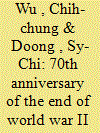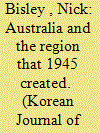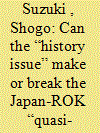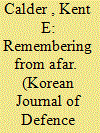|
|
|
Sort Order |
|
|
|
Items / Page
|
|
|
|
|
|
|
| Srl | Item |
| 1 |
ID:
139074


|
|
|
|
|
| Summary/Abstract |
In the closing stages of the Second World War, the world was divided into the capitalist side led by the United States and the communist side commanded by the USSR. A new bipolar structure called the “Cold War” was gradually established in the second part of the twentieth century. Basically this “cold” war structure was maintained between the two superpowers in the major areas of the world like Europe, but neither in the Korean peninsula nor in Vietnam, nor in Taiwan Strait since several “hot” wars took place in these regions.1 During that period, South
Korea, South Vietnam and Taiwan all had the support of the United States to resist the military threat of the other side supported by the communist USSR and China. Later, the capitalist South Vietnam was unable to resist the invasion of the North and collapsed. On the other hand, South Korea succeeded in developing the strength of the country and became a major middle power in the world. For strategic reasons, Taiwan lost formal political recognition of the world to the
profit of Communist China, but continues to flourish until now. The two Vietnams and the two Koreas all have similar sizes in term of territory and population. By contrast, China is 268 times larger than Taiwan calculated by territorial size, 60 times bigger by population power, and is actually the second largest global economic power after the United States. Without diplomatic allies, besides some smaller states, Taiwan still continues to prosper with its special security strategy. Seventy years after the end of the Second World War, this article aims to provide an understanding of the geopolitical strategy of Taiwan that continues to guarantee its future.
|
|
|
|
|
|
|
|
|
|
|
|
|
|
|
|
| 2 |
ID:
139069


|
|
|
|
|
| Summary/Abstract |
In consideration of the great symbolism of the year 2015, we are publishing the Summer 2015 issue of The Korean Journal of Defense Analysis as a special issue on the 70th anniversary of the end of WWII. We in the Editorial Committee of the KJDA would like to express our heartfelt thanks to distinguished professors, researchers, experts, and readers for their recognition of our work on this edition and their efforts to collaborate with us.
|
|
|
|
|
|
|
|
|
|
|
|
|
|
|
|
| 3 |
ID:
139076


|
|
|
|
|
| Summary/Abstract |
This paper examines the importance of the postwar settlement to Australian international policy. In particular, it considers how the postwar settlement of American regional primacy and economic dominance became built into the foundations of Australian international engagement and its long-term consequences. The first part of the paper explains how this occurred and why it is so important to Australia’s current policy dilemmas. The second part of the paper examines how changes to the fundamental structures of the 1945 regional strategic settlement, focusing primarily on Northeast Asia, are driving shifts in Australian policy. It concludes with a reflection on the choices Australia has made about its strategic future as it is heavily invested in the belief that U.S. primacy can endure over the long term.
|
|
|
|
|
|
|
|
|
|
|
|
|
|
|
|
| 4 |
ID:
139073


|
|
|
|
|
| Summary/Abstract |
Japan and the Republic of Korea (ROK) are said to have been in a “quasialliance” since the Cold War period, drawing closer at times during doubts over U.S. security commitment to Asia. In recent years, however, this status quo appears to have changed. Despite anxieties of U.S. retrenchment, the relations between the two states have hit an all-time low because of arguments over how the history of Japanese imperialism should be remembered, and they show no signs of improving. Does this mean that the quasi-alliance has ended? This article
examines this question, and concludes that the quasi-alliance between Japan and South Korea has broken down because of escalating arguments over the “history issue.” Japan-ROK bilateral relations are dogged by misunderstandings of each other, and that this is needlessly distancing the two states from one another. The termination of the Japan-ROK quasi-alliance because of the “history issue” is, on balance, a negative development for the security of the Asia-Pacific and a demonstration of short-term political judgement. If the two states are serious
about resolving this deadlock, both need to overcome mutual stereotypes that are
“taken for granted.”
|
|
|
|
|
|
|
|
|
|
|
|
|
|
|
|
| 5 |
ID:
139071


|
|
|
|
|
| Summary/Abstract |
East Asia is now fully engaged in a competition between a rising China and the other powers—the United States and Japan—while the regional order is in a transition from a super primacy of the United States to the asymmetric bipolar structure of the United States and China. China is changing a lot in terms of capabilities and behavior; but China also shows its benevolence, such as benefit-sharing initiatives on regional institutionalization development. The “American rebalancing strategy” has partly reversed the overall situation in East Asia in favor of the United States, but as 57 countries have joined the Asia Infrastructure Investment Bank (AIIB), Beijing has now recovered some ground from this overwhelming tide of the U.S. strategy. China’s military modernization and Sino-Japanese confrontation over
the Diaoyu Islands offer a big excuse and incentive for Japan’s acceleration of this process of becoming a normal country. The future of Northeast Asia lies mainly in the four variables and their interactions: the Chinese Communist Party’s capability to balance its goal of national rejuvenation and nationalistic emotion in protecting its sovereignty interests; the United States’ genuine attitude toward China’s power development; Japan’s goal of its nationalistic resurgence and its complicated strategic ties with China and South Korea; and North Korean regime stability and nuclear capability development. In spite of the Sino-American competition relations, there always exists a demand of condominium and strategic interdependence on global governance and other hot issues in the international arena. Therefore, management of China-U.S. competition is key to stability of the regional order.
|
|
|
|
|
|
|
|
|
|
|
|
|
|
|
|
| 6 |
ID:
139070


|
|
|
|
|
| Summary/Abstract |
The United States shares with many Pacific powers both relief that the world returned to peace, after the greatest conflagration in world history, and pride in its role in the subsequent transformation of world affairs. Human rights and human dignity strike a deep chord with Americans. Distinct from Asian nations on whose soil the war was largely fought, however, the United States is more detached, in general, from wartime bitterness, and places priority on forward-looking, multi-tiered institution-building across Northeast Asia. Stable relations of mutual respect among the United States and its two major regional allies, the Republic of Korea and Japan, are a special priority, with broader regional confidence-building also considered important.
|
|
|
|
|
|
|
|
|
|
|
|
|
|
|
|
| 7 |
ID:
139077


|
|
|
|
|
| Summary/Abstract |
The year 2015 has many implications for South Korea. It marks the 70th anniversary of the end of World War II in 1945, the subsequent independence of the Korean Peninsula from the rule of Imperial Japan, and the division of the Peninsula into two Koreas based on two different ideologies and political systems. South Korea, based on liberal democracy, has renovated itself and emerged as a middle power with diplomatic and economic strength. However, the unhappy legacy of 1945 still haunts today’s ROK despite its growth, both in quantity and quality. The
U.S.-led regional order in the post-War period is experiencing a massive upheaval, as the United States seeks to maintain the status quo by using Japan, and China intends to shape a new regional order. Against this backdrop, South Korea is being demanded to choose a position. In order to deal with this situation, Seoul should put its national interest as its top priority, while taking into account which option serves better for regional peace and prosperity.
|
|
|
|
|
|
|
|
|
|
|
|
|
|
|
|
| 8 |
ID:
139072


|
|
|
|
|
| Summary/Abstract |
Russia continues struggling with its identity, leaning either toward being a European or an Asian country, or representing the link between the two regions. Recently there has been a Russian “pivot” to Asia, but, as opposed to U.S. rebalancing in this region, Russia does not intend to assume a leadership role and streamline the ongoing political and economic process in accordance with the superpower’s interests. Rather, Russia shows intent to try to fit in more actively in the existing Asia-Pacific order and engage on an equal basis with other members of the region. While this process started earlier, charted by Primakov’s “strategic triangle”
idea and multi-vector diplomacy, recent confrontation with the West significantly sped up the process. This article intends to review the evolution of Russia’s conceptual understanding of Asia and its own place and role in the Asia-Pacific region. Further on, the author attempts to take a brief look at major developments happening in the region, review its conflict potential and define the role of its main players. While those factors are reviewed, there is no intention to attempt a comprehensive description of the situation in the Asia- Pacific, but rather to offer an account of existing opportunities and challenges through Russia’s interests and views.
|
|
|
|
|
|
|
|
|
|
|
|
|
|
|
|
| 9 |
ID:
139075


|
|
|
|
|
| Summary/Abstract |
The present article looks at the 70th anniversary of the end of the Second World War from an historical and comparative perspective, scrutinizing the diverging pathways established in Europe and Northeast Asia in the aftermaths of such a tragic event with regard to the construction of a new security architecture. In order to grasp the rationale behind the widely different outcomes of these processes within the selected case studies, the first section will highlight the fundamental steps and prerequisites that paved the way for the consolidation of a
Euro–Atlantic security community, characterized by peaceful interactions among its members based on shared values and identities. Accordingly, it will emphasize the fundamental importance of historical reconciliation efforts pursued since 1945 by European states—most notably between France and the Federal Republic of Germany—as well as the contribution of innovative multilateral institutions, such as the North Atlantic Treaty Organization (NATO) and the Organization for Security and Cooperation in Europe (OSCE), in laying the foundations of an
unprecedented defense framework. Northeast Asia’s trajectory, on the other hand, will be at the core of the second section, aimed at examining the roots of its prolonged reliance on traditional bilateral ties built on the American “hub–and–spokes” system, which ultimately hindered the possibility of replicating in the area the main features of Europe’s collective security echanisms. Finally, the last section will focus on the recent impact of this peculiar path on several major issues that nowadays stand at the top of the regional security agenda—as in the case of the mutual grievances among the People’s Republic of China, Japan, and South Korea produced by controversial memories of WWII—arguing that the absence of shared narratives concerning such a paramount conflict represents a fundamental impediment to the establishment of a cooperative security environment in Northeast Asia.
|
|
|
|
|
|
|
|
|
|
|
|
|
|
|
|
|
|
|
|
|